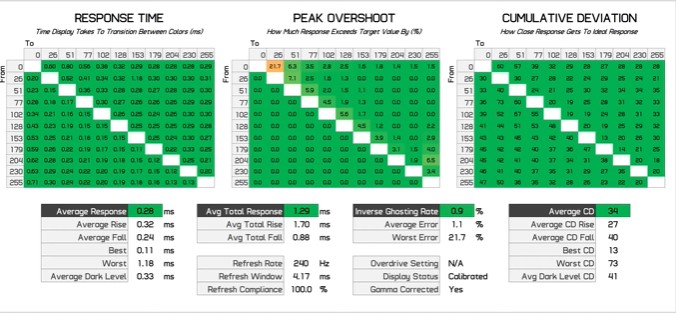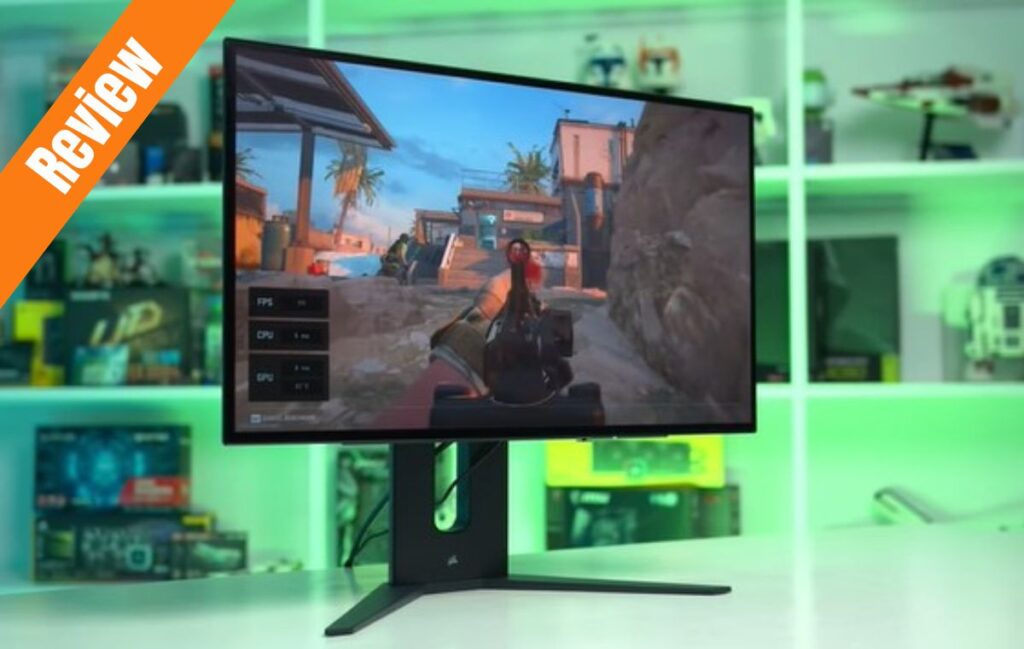The Corsair Xenon 27QHD240 monitor is packed with outstanding features: a 27-inch display with a sharp 1440p QHD resolution, a rapid 240Hz refresh rate, and, notably, an OLED panel. This Corsair gaming monitor uses an LG OLED panel, renowned for its exceptional display quality.
The Corsair 27WHD240 stands out as a top-tier OLED gaming monitor, delivering remarkable gaming performance and breathtaking visuals. Boasting a 27-inch panel and QHD resolution, it ensures a crisp and detailed display. The incorporation of OLED technology enhances the visual experience with deep blacks, vibrant colors, and exceptional contrast, making it a favored option for both gamers and content creators.
Design and Ports

The Corsair 27QHD 240 stands out with its sleek and minimalist design, distinguishing itself from many high-end products by avoiding the use of RGB LED lighting gimmicks. Instead, it prioritizes a clean and elegant aesthetic.
The rear of the monitor is designed with easily accessible ports, strategically positioned for convenient connectivity. The port selection comprises one DisplayPort 1.4, two HDMI 2.1 ports, and a USB hub equipped with four Taipei ports. Furthermore, the monitor’s stand provides excellent adjustability, including options for height, tilt, pivot, and swivel.
Anti-Glare Coating

The Corsair model uses a matte anti-glare coating. This choice is reasonably controversial among OLED enthusiasts, some of whom prefer a glossy experience. However, in my review of the original LG model, I mentioned that I believe this is one of the better matte screen coatings. It is on the heavier side, so those who dislike any visible grain from the coating may not be huge fans. Nevertheless, it does an excellent job of eliminating reflections, reducing diffuse light, and preserving OLED blacks. In general, here are my thoughts on matte versus glossy:
- If you are using this display in a brightly lit room, if there are light sources directly in front of the display, or if you can’t control room lighting well with blinds, a matte coating for an OLED is preferable. The 27QHD240 looks great in these conditions.
- In a dimly lit room with ambient light or if you can optimize the lighting in the room by placing light sources behind the display or using blinds, a glossy finish is preferable, as it will look richer and clearer.
- In a dark room, such as gaming with the lights off, there is almost no difference between glossy and matte, with a slight advantage to glossy as it will have no grain related to the coating.
Read Also: ASUS ROG Swift PG27AQDM Gaming Monitor Review
Subpixel and Burn-In

The WOLED subpixel array poses challenges for desktop use, particularly due to the noticeable issues amplified by the size and resolution of the 27-inch, 1440p panel. In contrast to larger 42-inch panels with 4K resolution, which were often viewed at a distance or used resolution scaling, the closer viewing and 100% scaling with this panel reveal more significant problems with the WOLED.
A key concern arises from the use of an RWBG layout instead of the traditional RGB layout expected by operating systems for rendering text using modern subpixel rendering techniques. The additional white subpixel in WOLED alters the rendering of each color, leading to blurriness and a shadow-like effect on fine elements like text. Personally, I find this quality inferior to that of an RGB subpixel LCD, making the monitor less suitable for desktop use or productivity tasks.
This issue is compounded by the risk of permanent burn-in associated with prolonged static elements on an OLED screen, common in desktop scenarios. While OLED is generally fine for content consumption like watching videos or playing games, static elements such as a toolbar can lead to burn-in over time. Hence, I do not recommend using OLED as a productivity monitor.
However, Corsair’s OLED monitor comes with a notable advantage, a best-in-class warranty spanning three years, inclusive of burn-in coverage for the entire period. In contrast, both LG and Asus monitors only offer two-year warranties without burn-in coverage, according to Corsair.
Response Time Performance

The Corsair Xenon 27QHD240 delivers exceptional motion performance, thanks to its OLED panel. With an average response time of 0.28 milliseconds and minimal overshoot, it provides smooth and blur-free gaming experiences. The monitor maintains excellent performance across different refresh rates, making it an ideal choice for both competitive multiplayer gaming and immersive single-player experiences.
Color Performance

The color performance of the Corsair Xenon 27q HD 240 is impressive, as expected from an OLED panel. It offers 97% DCI-P3 coverage, resulting in vibrant and accurate colors. Xenon 27q monitor’s factory calibration is commendable, especially in the sRGB mode, where it outperforms its competitors, such as the LG and Asus variants. However, it’s worth noting that there are some saturation and luminance issues in the HDR mode, leading to weaker color accuracy.
Brightness, Contrast, and Uniformity

One aspect where the Corsair Xenon 27QHD240 falls slightly behind its competitors is brightness. While it provides decent brightness for HDR content, its SDR brightness is noticeably lower compared to other OLED monitors using the same panel. This might impact the viewing experience in brightly lit environments. The monitor’s black levels are excellent, thanks to its OLED technology, which allows for true blacks by turning off individual pixels.
HDR Performance

The Corsair Xenon 27QHD240 delivers a great HDR experience, leveraging the inherent capabilities of OLED technology. OLED panels can individually control each pixel’s brightness, resulting in deep blacks and precise highlight details. Compared to LCD monitors with local dimming, OLEDs have an advantage in displaying clean HDR content with minimal blooming or haloing. However, the monitor’s HDR accuracy falls behind its competitors, with issues in EOTF tracking and color performance.
HUB Essentials Checklist



The Corsair Xenon 27QHD240 checks several essential features on the HUB checklist. It offers HDMI 2.1 support, ensuring compatibility with the latest gaming consoles and high-bandwidth devices. The monitor also provides good factory calibration, surpassing the performance of the LG and Asus variants. However, the color space coverage is slightly lower than advertised. The monitor’s brightness reaches 450 nits, but it’s important to note that this applies to HDR and not SDR content.
Final Thoughts
Overall, the Corsair Xenon 27QHD240 is a solid OLED gaming monitor with impressive motion performance and excellent gaming capabilities. It delivers stunning visuals and deep blacks thanks to its OLED panel. However, it falls short in terms of brightness, especially in SDR mode, compared to its competitors like the Asus variant. HDR accuracy and color performance could also benefit from improvements through firmware updates. Pricing plays a significant role in the purchase decision, and Corsair should aim to offer a competitive price point below the Asus model to attract buyers.
In conclusion, the Corsair Xenon 27q HD 240 is a solid choice for gamers seeking an OLED gaming monitor with excellent motion performance and impressive visuals. While it has some drawbacks, such as lower brightness and HDR accuracy compared to its competitors, it still offers a great gaming experience. Customers should weigh the pros and cons and consider pricing to make an informed decision.

